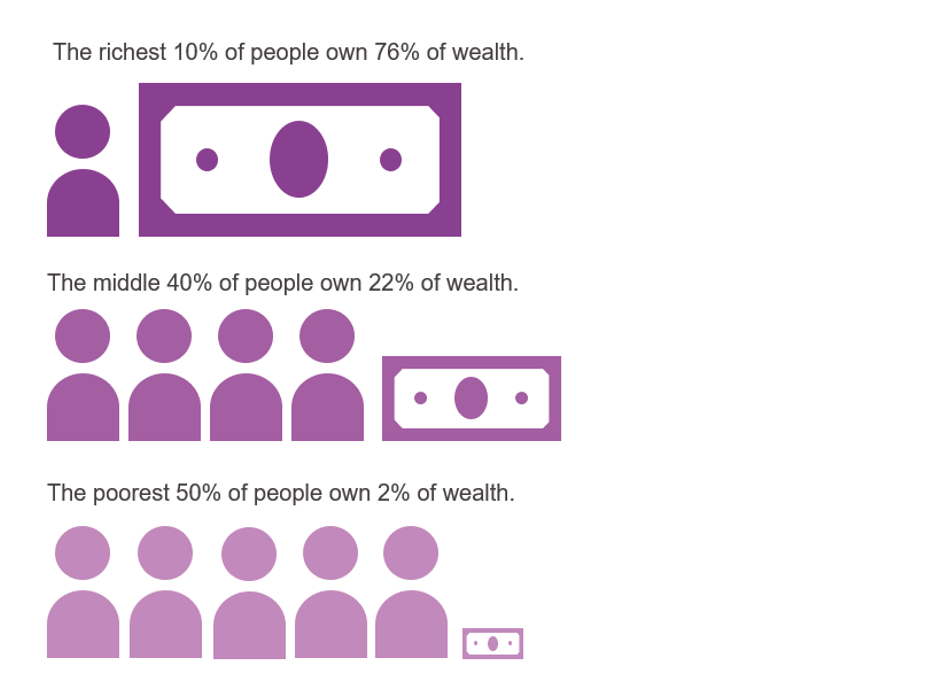Inequality: Global trends
This factsheet presents and interprets recent trends in levels of inequality globally using a number of different datasets.
DownloadsIntroduction
Inequality is all about the distribution of power and resources, the rights people can exercise, and the opportunities they can access. Some amount of inequality is inevitable. But inequality is problematic when it prevents people from living decent lives and fulfilling their rights. Since the Covid-19 pandemic, wealth inequality has escalated, further distorting power dynamics and impeding progress on reducing poverty in all its forms. This 2023 update to DI's annual inequality factsheet presents and interprets the most recent trends in global inequality.
Inequality is closely linked to poverty. We cannot hope to reduce poverty without addressing inequality. The relationship between the two is complex and includes several dimensions:
- Much of poverty is relative. The context in which a person lives and the outcomes of others in their community has an important impact on their experience and what is necessary for them to participate fully in their society.
- Environmental resources are finite, so where wealth exists alongside deprivation, it is necessary to think about how available resources are distributed.
- Recognising and understanding horizontal inequalities, where people face exclusion and discrimination based on their identity, is critical to tackling the root cause of poverty and to leave no one behind.
- Economic inequality is closely linked to political inequalities, which create a self-perpetuating cycle, reinforcing division in society as the poorest people have less influence over political decision-making than the wealthiest people.
There is no single measure that can capture all aspects of inequality, nor a single dataset that provides comprehensive and timely data to underpin all inequality measures. As such, the facts and statistics included in this factsheet draw on several different datasets and use a variety of measures to understand the levels and trends of inequality. Each inequality measure and underlying dataset has strengths and limitations and should be understood and interpreted based on this.
Our briefing on gender data looks specifically at the challenges and opportunities associated with the collection and use of data that can provide evidence of gender inequality, identifying key gender data gaps to be addressed.
► Read our briefing on improving gender data to reduce inequality .
► Learn more about multidimensional poverty .
► Use our interactive charts to view trends in economic poverty.
Key facts
- The world is vastly unequal, extreme wealth coexists with extreme poverty . The poorest 50% of the global population share just 8% of total income. At the same time, the richest 10% of the global population earn over 50% of total income.
- Between countries, income inequality is high, but the gap may be narrowing . Between-country inequality accounts for two-thirds of global income inequality. However, between-country inequality has decreased as previously low-income countries such as China and India have experienced faster growth than higher income countries. The data emerging since 2020 suggests that global inequality may have increased in recent years.
- The Covid-19 pandemic contributed to a rise in the unequal distribution of wealth. When measuring economic inequality by wealth, that is the total amount of assets financial and non-financial, less debt that a person owns, the gap is even bigger than that measured by income. The wealthiest 10% of people in the world own 76% of total wealth. During the Covid-19 pandemic, billionaires around the world added US$1.9 and US$1.6 trillion to their net wealth in 2020 and 2021, respectively.
- Compounding crises threaten to exacerbate the disadvantages experienced by low-income countries (LICs) . LICs face a much harder recovery from the multiple shocks of the Covid-19 pandemic, climate change, conflicts and the rising cost of living as they have lower financial capacities to fund economic recovery.
- Low-income countries, which did the least to cause climate change, will face the biggest costs . Between-country inequalities are likely to grow as the devastating and costly impacts of climate change are felt more acutely in LICs.
- Development finance can be better used as a tool to tackle inequality . Finance that redistributes resources from high- to low-income countries to reach the people living in the greatest poverty can help reduce inequalities between and within countries. Official development assistance (ODA) in particular, is conceptually well placed to tackle the most complex needs in least developed countries (LDCs), but its current scale and allocations fall short of this potential.
- Economic inequalities intersect with horizontal inequalities . Personal characteristics, such as gender , age, disability status, ethnicity, religion, migrant status and/or geography, can also intersect to exacerbate inequalities experienced by particular individuals and groups.
- Inequalities within countries are influenced by many factors . The level of inequality within any given country or community depends upon numerous structural and contextual factors. Policy responses can also have a significant impact on inequality.
The world is vastly unequal, extreme wealth coexists with extreme poverty
The World Inequality Report estimated that in 2021, the total global income was $122 trillion (measured in 2017 Purchasing Power Parity or PPP), and the global adult population was 5.1 billion. [1] If this income was shared equally between all adults around the world, this would equate to PPP$23,380 yearly. [2]
Further data from the World Inequality Report suggests that the reality is very different from this.
- People in the poorest 50% of the global population share just 8% of global income between them. They earn on average PPP$3,920 per person, per year ($10 per day).
- Meanwhile, the richest 10% of people in the world are estimated to receive more than half of global income (52%), earning on average PPP$122,100 per person, per year ($334 per day).
Between countries, income inequality is high, but the gap may be narrowing
Between-country inequality is the difference in average incomes in different countries. The country in which you are born is a critical factor in where you are likely to be on the global income distribution. Between-country inequality accounts for two-thirds of global income inequality.
Between-country income inequality narrowed in the decades before the Covid-19 pandemic as previously low-income and high-population countries such as China and India experienced faster growth than high-income countries.
One of the key measures of inequality is the Gini coefficient: a measure of how unequal income, consumption or wealth are distributed. A Gini coefficient of 0 indicates perfect equality and 100 indicates complete inequality. More information about the Gini coefficient can be found here .
Figure 1: Between 1990 and 2020, the global Gini coefficient has decreased, largely driven by decreasing inequality between countries
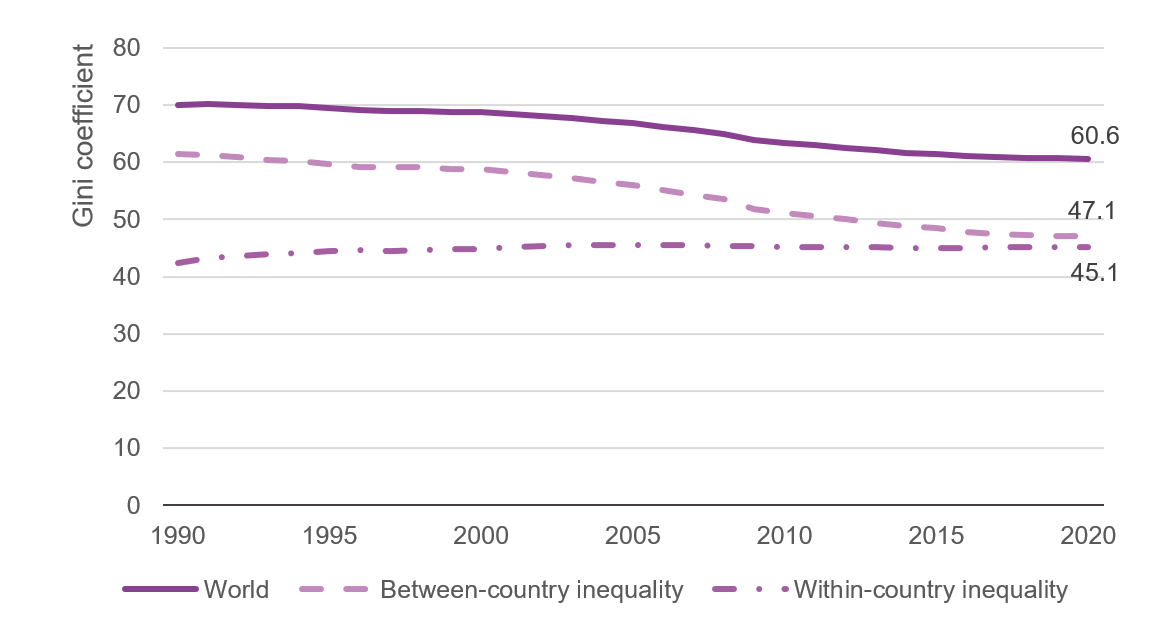
Chart showing that between 1990 and 2020, the global Gini coefficient has decreased, largely driven by decreasing inequality between countries.
Source: Development Initiatives based on UNU-WIDER, World Income Inequality Database (WIID) Companion dataset (wiidglobal). Version 30 June, 2022.
Note: Inequality as measured by the Gini coefficient.
Figure 1 was produced by the UNU WIDER and suggests that in 2020, the global Gini coefficient decreased by 0.1 point (from 60.7 to 60.6) due to a reduction in within-country inequality while the between-country Gini coefficient stayed constant between 2019 and 2020. Other estimates provide a different narrative on what happened to global inequality in 2020.
Figure 2: The global Gini coefficient increased in 2020 after generally decreasing in recent decades
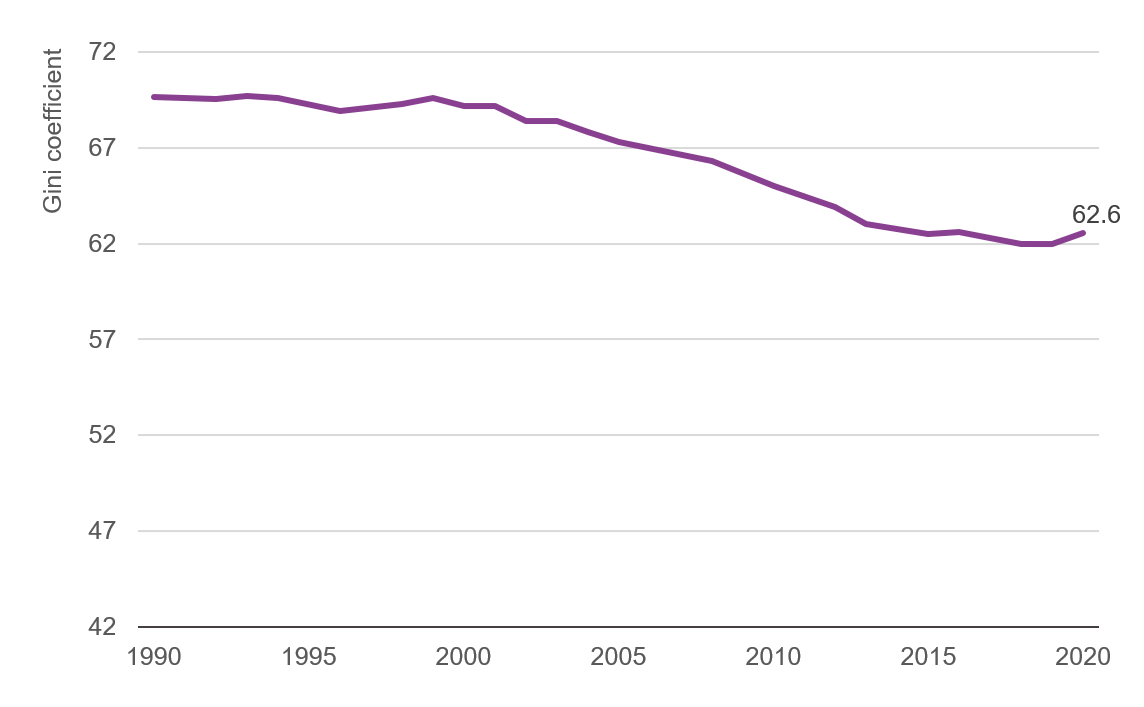
Chart showing that the global Gini coefficient increased in 2020 after generally decreasing in recent decades.
Source: Development Initiatives, based on Mahler, D., et al. ‘Nowcasting Global Poverty’, Policy Research Working Paper; No. 9860, World Bank, Washington, DC., World Bank, 2021.
Mahler et al. (2022) generated estimates based on dozens of high-frequency mobile surveys conducted in 2020 and 2021. These estimates find the single highest annual increase in global Gini in 2020 (a 0.7-point increase from expected trends). This was almost entirely driven by an increase in between-country inequality as the impact of the Covid-19 pandemic had a more pronounced impact on LICs. During this period, within-country inequality stayed roughly the same, on average, with some variation between countries.
Estimates from the IMF published in April 2023 suggest that while almost all countries have experienced slower-than-expected GDP per capita growth between 2021 and 2023, Sub-Saharan Africa has seen slower expected growth than advanced economies, while emerging Asian economies are estimated to have outpaced both regions.
The Covid-19 pandemic contributed to a rise in the unequal distribution of wealth
When measuring global economic inequality by wealth, the gap is even bigger than that measured by income. Wealth includes the value of financial and non-financial assets, net of debt. Wealth can provide the means for people to be able to respond to any financial shock, such as an unexpected medical bill or a poor harvest, as well as to invest in their future.
According to the World Inequality Report :
- The poorest 50% of the population own just 2% of total net wealth, an average of PPP $4,100 per adult in 2021.
- The middle 40% of people own 22% of total net wealth, an average of PPP $57,300 per adult in 2021.
- The richest 10% of people own 76% of total net wealth, an average of PPP $771,300 per adult in 2021.
Between countries, the difference is also stark. According to Credit Suisse’s Global Wealth Report , countries in North America and Europe together account for 57% of total household wealth but contain only 17% of the world adult population (2021 figures). Conversely, countries in Africa account for 1% of wealth and 13% of the adult population.
The Global Wealth Report further indicates that total global wealth grew by 9.8% in 2021, totalling US$463.6 trillion. This wealth accumulation was concentrated at the very top of the global distribution, where people are already wealthy. Billionaires have seen their share of global wealth rise since 1995 and this trend was accentuated during the Covid-19 pandemic with a record increase in 2020.
While some regions experienced negative growth in 2020 due to the shock of the Covid-19 pandemic, all regions saw their wealth increase in 2021. Credit Suisse estimates further indicate that the most notable increases in total wealth were observed in North America (15.5%) and China (15.1%). They are followed by India (12.0%) and Latin America (10.5%), both recovering from negative growth the previous year. [3] Total wealth also grew in Africa (7.7%) and Asia-Pacific (5.6%), while Europe recorded the lowest growth (1.5%). Debt increased in all regions except Europe. However, changes in debt have not affected overall net wealth as much as financial and non-financial assets.
Figure 4: All regions saw wealth per adult increase in 2021, reversing 2020 trends, but significant differences remain
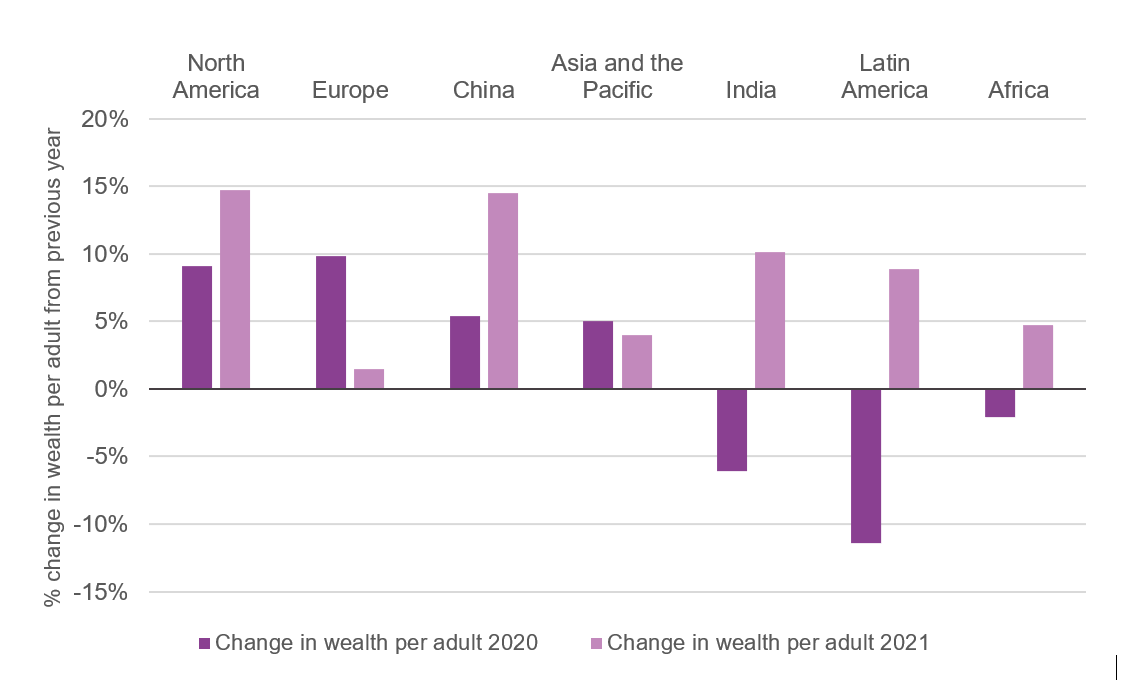
Chart showing that all regions saw wealth per adult increase in 2021, reversing 2020 trends, but significant differences remain.
Development Initiatives based on Credit Suisse, 2022. Why wealth matters. The Global Wealth Report. p.10; and Credit Suisse, 2021. The Global Wealth Report, p.7.
Note: Credit Suisse report India and China alongside regional averages due to their relative size.
Compounding crises threaten to exacerbate the disadvantages of low-income countries (LICs)
Long-term, between-country differences caused by the Covid-19 pandemic have now become clearer. High-income countries have navigated the impacts of the pandemic through stimulus packages, estimated at over US$16 trillion globally. Meanwhile, in LDCs, stimulus packages per person were almost 500 times less than richer countries. [4] Within countries, the longer-term economic impacts of stimulus packages still need to consider distributive impacts, taking into account how increases in public debt are managed and affect different groups in the population.
The absence of income support for countries in Africa and Asia has particularly affected vulnerable groups such as women, minorities and young people. An estimated 50 million more people were pushed into income poverty in 2020 in the lowest-income countries, where there is an absence of both established social protection mechanisms as well as those put in place as part of the Covid-19 response.
Moreover, vaccine inequity , with huge disparities in first doses as well as boosters persisting into 2023, has resulted in unequal economic recovery trends among country groups. High-income and upper-middle-income countries are forecasted to make a stronger recovery than originally expected, while lower-middle-income and low-income countries are projected to continue on a downward trend.
People living in LICs have been disproportionately affected by the Covid-19 pandemic, the climate crisis, and rising living costs due to the war in Ukraine. A high proportion of the world’s food and energy insecure population live in LICs; this has made these people particularly vulnerable to rising food and energy prices. These mutually reinforcing shocks are felt more acutely in contexts where people may already live in extreme poverty.
Figure 5: Share of the unvaccinated in population by World Bank country income group
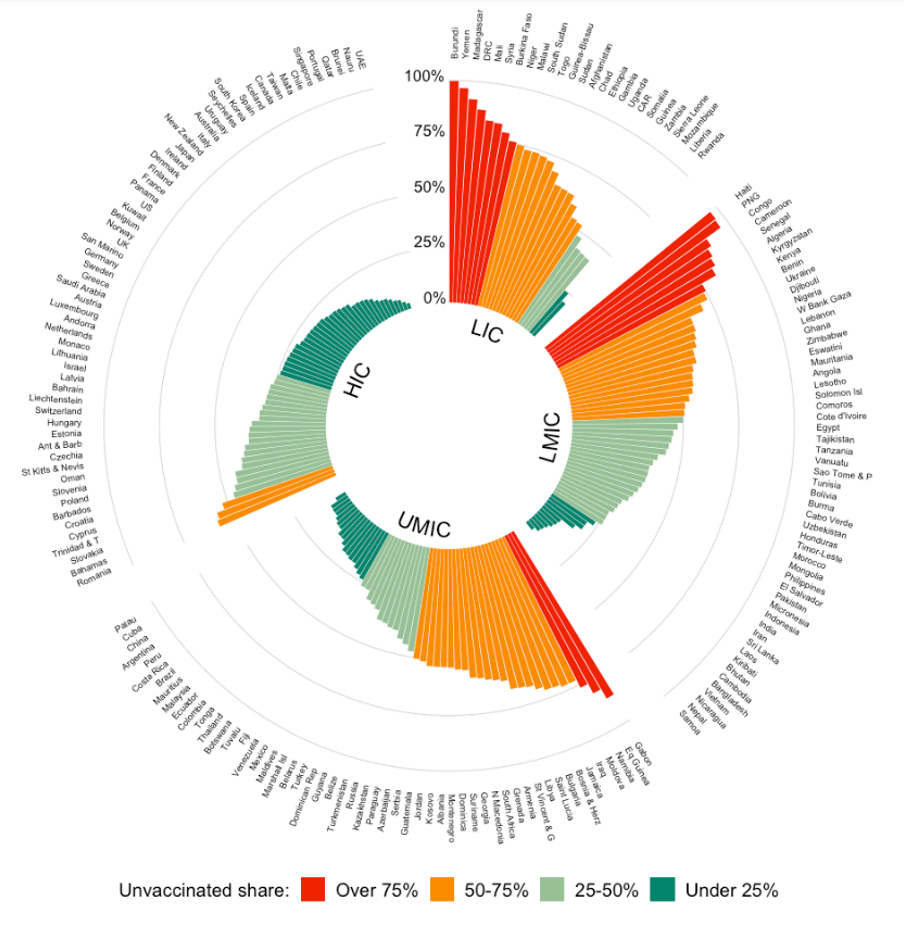
Chart showing the share of the unvaccinated in population by World Bank country income group.
Source: OWID; WPP. Updated 13/04/2023. Used under CCBY 4.0 licence.
Note: Acronyms: high income countries (HICs), upper middle-income countries (UMICs), lower middle-income countries (LMICs) and low-income countries (LICs).
Low-income countries, which did the least to cause climate change, will face the biggest costs
Carbon emission data finds that the highest emitters, and those most responsible for climate change, are people with the highest incomes. According to the World Inequality Report, the 3.8 billion people that make up the poorest 50% of people contribute to just 12% of total carbon emissions. Meanwhile, the richest 10% of people on the planet, 771 million people, are responsible for 47.6% of global carbon emissions.
Historically, global carbon inequality was mostly due to differences between countries, whereby the average citizen in a richer country emitted more carbon than the average citizen in a poorer country. However, according to the World Inequality Report, within-country inequalities account for nearly two-thirds of global emissions inequality, as the highest emitters within any given country pull away from the rest. Since 1990, the emissions of the richest 1% of individuals around the world grew by 21% and the emissions of the top 0.01% grew by 168%.
All countries will need to adapt to climate change, but climate change will disproportionately affect LICs, despite them having emitted the least carbon historically. This is largely due to the geography and climate in LICs, as well as socioeconomic conditions, dependence on natural resources and limited adaptation capacities. Research by Christian Aid estimates that even if warming is limited to a 1.5°C target, climate change could cause a 33.1% GDP hit to the world's most vulnerable countries by 2100; in projections, Sudan is the worst-affected country. Within countries, the impacts of climate change will also differ, with the people living in the greatest poverty likely to be most affected due to the impacts on food systems and climate-sensitive livelihood activities such as farming, fishing, livestock production, and small-scale trade.
Figure 6: Correlation between vulnerability to climate change, CO2 per capita and GDP per capita
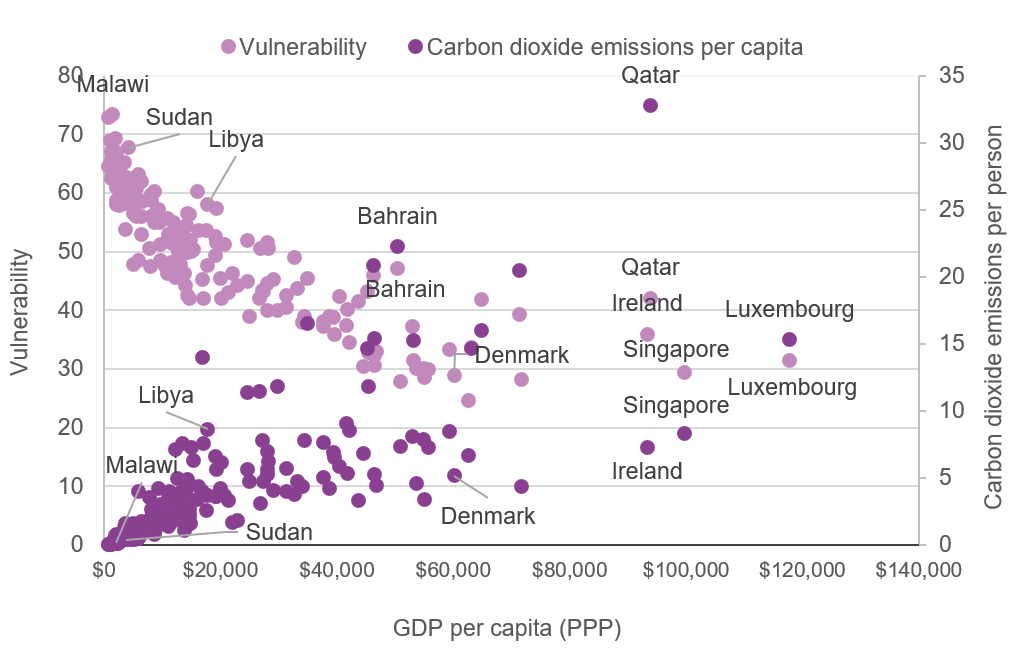
Chart showing the correlation between vulnerability to climate change, CO2 per capita and GDP per capita.
Source: Vulnerability scores from Notre Dame Global Adaptation Initiative. Carbon dioxide emissions and GDP from the World Bank.
Progress in the global economy has been built on a model of increasing consumption and resource extraction, which has led to catastrophic effects on our climate. In the context of almost 682 million people still living below the extreme poverty line, we must address the unequal distribution of resources, consumption and emissions to reduce poverty and the impact of climate change on vulnerable populations.
Development finance can be better used as a tool to tackle inequality
International development finance can redistribute money from high-income countries (HICs) to LICs. When effectively targeted to reach the people living in greatest poverty within a country, it can also help to reduce inequalities within countries.
International development finance includes official flows such as ODA grants and loans from international financial institutions; commercial flows, such as foreign direct investment (FDI); and private flows, such as remittances and philanthropy, which tend to originate in countries with higher incomes than where they are received. The extent to which this finance can reduce inequality depends on the terms associated with the contracts and how the money is spent in-country. Loans are an example of where an initial transfer of funds from a high-income country to a low-income country is followed by loan repayments and interest, which flow back in the opposite direction. Loans are making up an increasing share of development finance in countries such as Uganda and Kenya . Progressive development finance can also be undermined by illicit financial flows, which flow from LICs to tax havens and other entities in high-income countries. In Africa, the billions of dollars lost to illicit financial flows are almost equal to ODA and FDI according to UN estimates, undermining Africa’s ability to leave no one behind.
ODA in particular, is conceptually well placed to tackle the most complex needs in LDCs; it has a clear remit to deliberately transfer resources to the poorest people. The scale of ODA flows is small: calculated at US$186 billion in 2020 . However, it remains the most important source of development finance in the most fragile places. Fewer domestic resources and less income from key international financial flows (such as FDI, remittances and tourism) put more reliance on ODA as a key resource for the funding of basic human capital investments that tackle poverty.
But the eligibility for ODA funding has been expanding in recent years to include high-income countries, and the competition for ODA across multiple demands has diluted the potential for these funds to have a laser-like focus on getting to the poorest people in the poorest places first. Instead, according to analysis from the Center for Global Development, the very poorest countries received the least ODA per person living in poverty. ODA has not adapted to reflect changing distributions of poverty and the impacts of the pandemic. In particular, while it is estimated that in 2021 over half of the population living in extreme poverty were in LDCs, these countries received only 25% of ODA.
Figure 7: LDCs have a higher share of the global population of people living in extreme poverty while also receiving a lower share of ODA

Chart showing that LDCs have a higher share of the global population of people living in extreme poverty while also receiving a lower share of ODA.
Source: Development Initiatives based on OECD DAC and World Bank PovcalNet.
Note: LDC = least developed country; DAC = Development Assistance Committee (OECD). The 2025 DAC bilateral ODA to LDCs as a percentage of total share is based on applying the average annual change in ODA to LDCs as a percentage of the total over 2019–2021 into 2025.
Economic inequalities intersect with horizontal inequalities
People are more likely to experience economic hardship when they are discriminated against because of their identity, including gender, age, disability status, ethnicity, religion, migrant status and/or because of where they live. Horizontal inequalities are inequalities between groups with a common identity, which includes factors such as age, disability, gender and ethnicity. When these inequalities are combined – for example, a woman who is disabled and is part of an ethnicity minority – this can create multiple disadvantages, creating intersectional inequalities which are often mutually compounding. These horizontal inequalities also intersect to compound and exacerbate the inequalities felt by individuals and groups. Evidence shows that inequalities are commonly experienced by particular groups:
- Children are more likely to live in poverty compared with adults. They make up one-third of the global population yet represent half of the population that lives in extreme poverty. The poorest children are twice as likely to die compared with wealthier children. According to UNICEF , even in richer countries, one in seven children live in poverty. Cuts to essential services during the pandemic has affected educational achievements and health outcomes, and children from the poorest families that are unable to access IT equipment or broadband have been particularly affected.
- Women are more likely to find themselves in the bottom of the economic distribution. Most survey measures of economic poverty rely on data at the household level. Poverty rates of lone female-headed households tend to be higher compared with lone male-headed households, or where there is also a male and female present. However, the limitations of the data mean that we cannot identify differences within households where there are both male and females present. Clearer evidence exists on gender inequalities in other dimensions of poverty, including exposure to violence and discrimination in the workplace. Gender inequalities go beyond the economic sphere to include legal and cultural discrimination, and deprivations that are more likely to be faced by women and girls, including with respect to freedom of movement, land rights, access to education, maternal health, access to safe and legal abortions, gender-based violence (GBV), and political and decision-making power. Several indices compare the extent to which women fall behind in different countries across a range of measures. According to the International Labor Organization, only 23.3% of women in Afghanistan are active in the labour market and, on average, they earn 25% less than men.
- Persons with disabilities are more likely to experience negative socioeconomic outcomes, including poorer health, lower levels of employment and higher poverty rates. Children with disabilities face multiple forms of discrimination within the education environment, resulting in lower school attendance rates and therefore lower educational achievements, which ultimately impact employment in adulthood. Prejudice creates cross-cutting challenges and can lead to social isolation. However, there is notorious difficulty in calculating precise statistics on persons with disabilities due to the complexity of defining disabilities and the poor quality of the data available.
Inequalities within countries are influenced by many factors
The level of inequality within any given country or community, and its trend, depends on numerous structural and contextual factors. Policy interventions that either directly or inadvertently affect people differently across the income distribution can exacerbate or reduce the gaps in outcomes and opportunities.
For example, South Africa has one of the highest levels of inequality in the world, regardless of how you measure it. Structural inequalities from a legacy of discrimination under apartheid continue to determine the high levels of economic inequality. As a result, economic inequality is intrinsically connected to the horizontal inequality of race; Statistics South Africa estimates that Black Africans are most disadvantaged in employment and earn, on average, less than half of their white counterparts.
Where you live within a country can also change the inequality you may experience. Geographic inequalities within Kenya and Uganda are just as stark as the inequalities that are comparable between countries at a global level. In Kenya, 79% of people in Turkana live below the national poverty line compared with 17% in Nairobi. Geographic inequalities are also evident in Uganda, where 97% of the population in Buvuma lives in poverty, compared with 4% in Kampala.
Figure 8: Inequality of income within countries as measured by the ratio of the income of the richest 10% to the poorest 50%, 2021
Dark red countries have a higher (more unequal) ratio, while lighter yellow countries have a lower (less unequal) ratio.
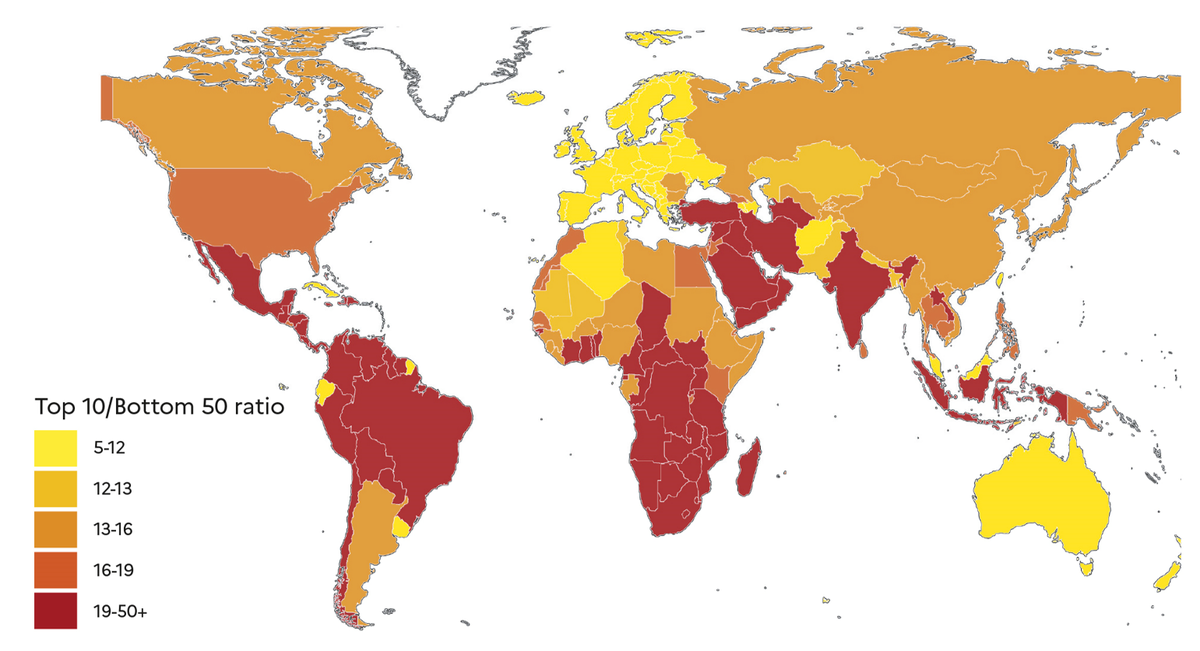
Chart showing income inequality within countries as measured by the ratio of the income of the richest 10% to the poorest 50%, 2021.
Source: Chancel, L., Piketty, T., Saez, E., Zucman, G. et al. World Inequality Report 2022, World Inequality Lab wir2022.wid.world, page 12. Used under Creative Commons License 4.0.
Economic inequality within countries can increase over time for many reasons. Liberal economic policies in some HICs during the 1970s and 1980s were associated with increases in income inequality. For example, according to Tax Policy Center the top rate of tax in the US fell from 70% to 28% during these decades, and the Gini coefficient also increased over this period from 0.35 to 0.37. Structural adjustment programmes from international finance institutions, such as the World Bank and the International Monetary Fund (IMF), also began in the 1980s. These led to a reduction in fiscal deficits but exacerbated inequality due to conditions set through lending programmes. For example, Forester, Kentikelenis, Reinsberg, Stubbs, and King (2019) find that expenditure reduction targets were passed on as a reduction in incomes for low-income households that rely on government transfers.
By understanding how different policies impact different groups, national governments can effectively reduce inequality, alongside meeting the other objectives of any given policy. For example, investments in universal health coverage can improve health outcomes, while disproportionately benefiting the most vulnerable people and thereby reducing inequalities. Similarly, social protection mechanisms can be deliberately targeted to reach the most vulnerable populations, including groups facing discrimination. Deliberately targeting spending towards people with the lowest incomes, or key human capital sectors, can be done through national , or subnational spending, while focusing revenue-raising efforts on those that can afford it the most.
Governments in Brazil and other countries in Latin America, which had among the highest levels of inequality in the world in the 1990s according to the IMF , successfully reduced their countries’ inequality between 2000 and 2014. They did this through progressive policies on social protection and education that targeted people with the lowest incomes. However, this progress has reversed in recent years, according to the World Inequality Database , with the top 10% of people in Latin America capturing around 58% of national income.
The polycrisis threatens to undo the progress made in recent decades on reducing inequality globally. Wealth and income remain highly concentrated in a small share of the global population. Tackling challenges related to inequalities in wealth and income, which often relate to discrimination based on identity, would move the world much closer to achieving the Sustainable Development Goals (SDGs). However, resolving these significant issues requires the reversal of many current trends.
Downloads
Notes
-
1
PPP stands for Purchasing Power Parity. Purchasing Power Parity helps to measure how incomes in a particular country are measured against goods and services, compared to other countries. This can be measured through how much a basket of goods might cost in one country, compared to another. Calculating figures of PPP is done by the International Comparison Programme, with the last available PPP figures being from 2017.Return to source text
-
2
World Inequality Lab, 2021. World Inequality Report 2022, chapter 1, p.26. Available at https://wir2022.wid.world/www-site/uploads/2021/12/Summary_WorldInequalityReport2022_English.pdfReturn to source text
-
3
Credit Suisse provides regional aggregates but also reports data for the individual countries of India and China due to the size of their populations.Return to source text
-
4
Calculation based on data from the IMF Fiscal Monitor: Database of Country Fiscal Measures in Response to the COVID-19 Pandemic, includes above-the-line measures and liquidity support. Data retrieved February 2023.Return to source text
Related content
Improving gender data to leave no one behind
Better gender data can reduce poverty and inequality. This briefing takes a solution-focused approach to the urgent challenge of closing the gender data gap.
Economic poverty trends: global, regional and national
Poverty is complex and it can be described and measured in a variety of ways. In this factsheet we unpack some of the key terminology alongside the latest trends in poverty at the global, regional and national levels.
Inequality, measuring it and why it matters for poverty reduction
This briefing explores the relationship between poverty and inequality, and shows that measuring, understanding and reducing inequality should be central to efforts tackle poverty, discrimination and exclusion.
